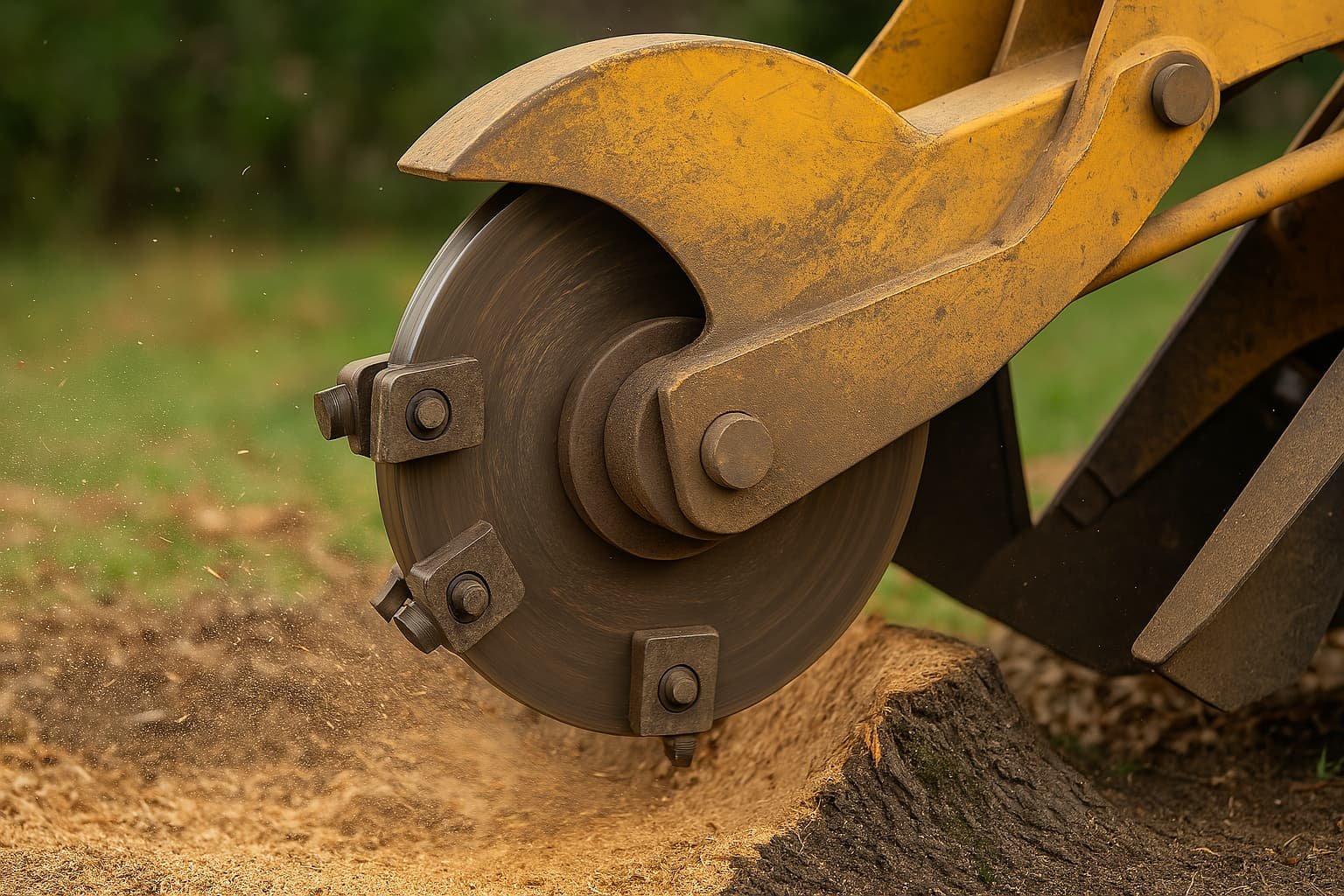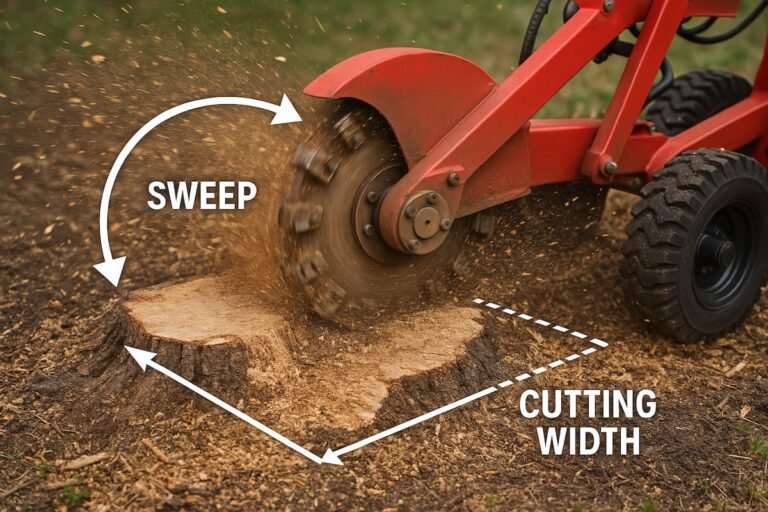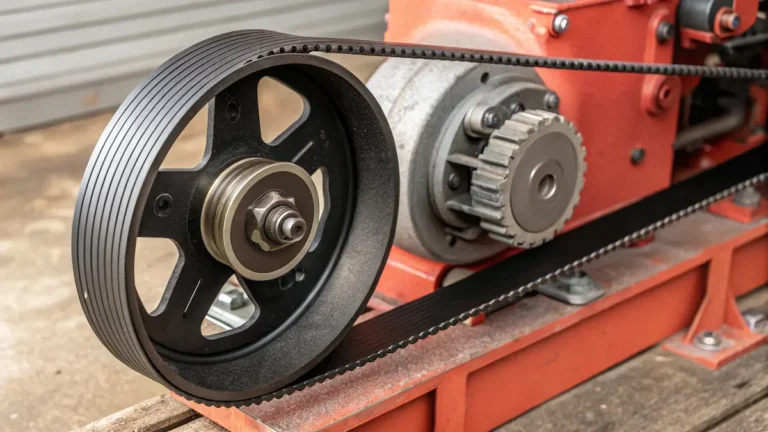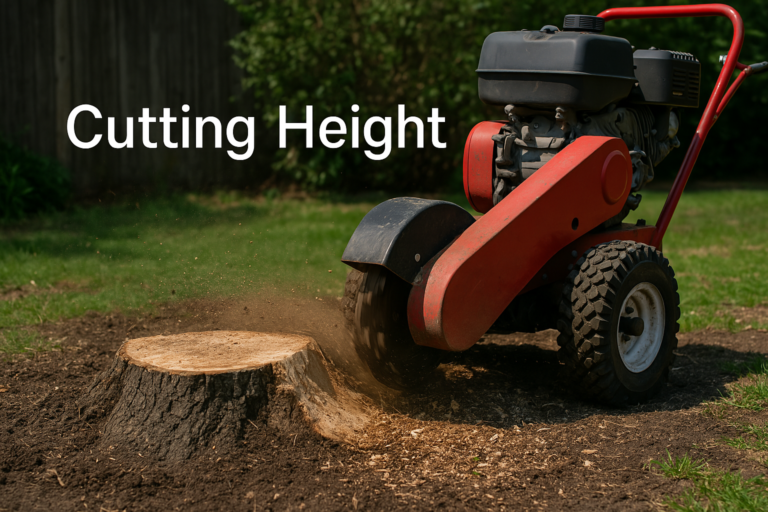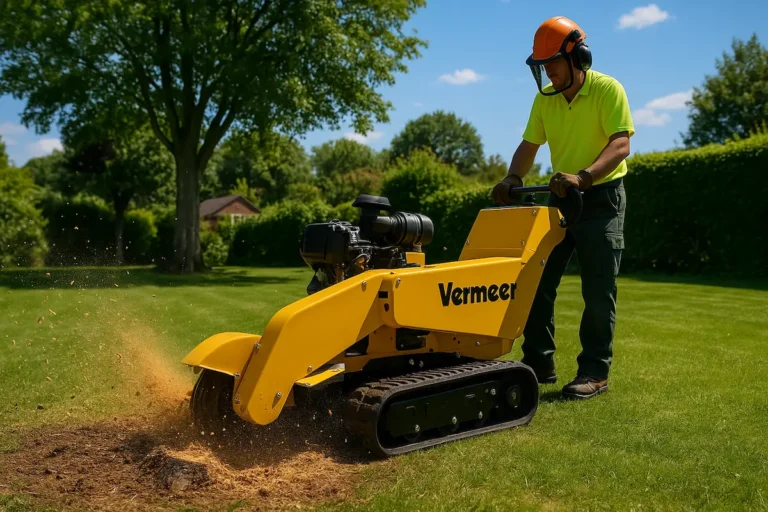Your Essential Guide to Stump Grinder Blade Pockets
Blade pockets hold the teeth on your stump grinder wheel.
They are super important for good grinding.
They also keep the machine safe to use.
This guide explains everything about them.
What Exactly is a Stump Grinder Blade Pocket?
A blade pocket is a unique metal holder.
It bolts onto the stump grinder’s big cutting wheel.
Think of it like a little seat for the grinding tooth.
It keeps the tooth securely in place while working.
It is also called a tooth pocket or cutter pocket.
Key Takeaways: Blade Pocket Incident Costs
- The chart visualizes the potential *range* of direct parts costs when hitting an object damages grinder components.
- Blade pockets represent the most significant variable cost component, ranging from £12 up to £40+ each.
- Even smaller items like teeth (£5-£15) and bolts (£2-£5) contribute significantly to the total expense.
- The stacked bars show the minimum (£19) and maximum (£60) estimated costs *for parts alone* based on the provided text ranges.
- Crucially, the actual incident cost including labour and machine downtime can easily exceed £80-£160, making preventative checks vital.
- Regular maintenance and inspection of pockets, teeth, and bolts can prevent these costly failures and enhance safety.
Pinpointing its Location on the Cutter Wheel
Look at the large, round cutting wheel.
You will see metal blocks bolted around its edge.
Sometimes, they are bolted onto the wheel’s flat face.
These blocks are the blade pockets.
Each pocket holds one grinding tooth.
Explaining its Primary Functions
The blade pocket has vital jobs to do.
- Holds the Tooth: It clamps the grinding tooth tightly. The tooth must not wobble or move.
- Transfers Power: It sends the wheel’s spinning power to the tooth. This lets the tooth cut the stump.
- Ensures Correct Angle: It holds the tooth at the perfect angle. This angle helps cut wood efficiently.
Examining Typical Materials and Construction
Blade pockets work very hard.
They face strong forces and lots of rubbing.
So, makers use powerful stuff to make them.
They usually use hardened steel.
This steel resists wear and tear.
It can handle bangs and bumps during grinding.
Why Blade Pocket Condition is Non-Negotiable in Stump Grinding
You must keep blade pockets in good shape.
Bad pockets cause big problems.
They affect how well the grinder works.
They can make grinding unsafe.
They can cost you money in repairs.
Maximising Grinding Efficiency: How Good Pockets Improve Cutting
Good pockets hold teeth firmly and at the right angle.
This means the grinder cuts smoothly and quickly.
You finish jobs faster.
Worn pockets let teeth move slightly.
This causes Vibration or ‘chatter’.
The grinder cuts slower and leaves a rougher finish.
A user on a tree service forum said this:
“Noticed my grinder wasn’t cutting clean. I found several pockets were dished out where the teeth sit. Replacing those worn pockets made a huge difference in smoothness.”
Ensuring Operator Safety: The Dangers of Pocket Failure
This is the most important reason to check pockets.
A cracked or broken pocket can fail suddenly.
If a pocket breaks, the tooth can fly off.
It shoots out like a bullet at high speed.
This is extremely dangerous.
It can seriously injure the operator.
It can hurt people nearby.
It can damage property like windows or cars.
Safe operation starts with secure teeth in strong pockets.
A Reddit user shared their scary moment:
PSA: Check your pocket bolts regularly! Yesterday, I had one back out mid-grind. Luckily, I didn’t lose the tooth or damage the wheel, but it could have been not good.
Preventing Costly Repairs: Protecting Teeth and the Cutter Wheel
Worn pockets do not support teeth properly.
This extra stress can break the grinding teeth.
Replacing teeth costs money and time.
If a pocket breaks or a bolt comes loose, it can damage more.
It might damage the expensive cutter wheel itself.
Replacing a cutter wheel costs much more than replacing pockets.
Think £1000s for a wheel versus £15-£50 for a pocket.
A tree care company wrote on their blog:
“We inspect pockets for cracks and wear during our daily machine checks. Replacing a £30 pocket is cheap insurance against a £2000 wheel replacement or a dangerous tooth ejection.”
Reducing Machine Downtime: The Financial Impact for Operators and Hire Firms
If your grinder breaks down, you lose money.
Operators cannot finish jobs or earn income.
Hire companies lose rental fees.
Fixing broken pockets or sheared bolts takes time.
You might need special tools to remove stuck bolts.
This Downtime stops the machine from working.
Regular checks and replacing worn pockets prevent unexpected stops.
It keeps the grinder earning money.
Exploring Common Types of Blade Pocket Systems
Not all blade pockets look the same.
Different grinder makers use other designs.
The type of pocket often matches a specific tooth system.
Understanding Standard (Square/Rectangular) Pocket Designs
These are traditional pocket types.
They look like simple square or rectangular blocks.
They bolt onto the cutter wheel.
Usually, one or two bolts hold the tooth in the pocket.
They are common on many older and some newer machines.
Recognising Popular Aftermarket Systems (e.g., Greenteeth® LoPro™)
Some companies make special pocket and tooth systems.
Greenteeth® LoPro™ is a very popular example.
Many operators upgrade to this system.
Their pockets often look slimmer.
They have a clever way to hold the tooth.
People like them because rotating or changing teeth is often easier.
Lots of YouTube videos show how to use Greenteeth pockets.
A YouTube commenter said about their hire machine:
“Switched to the LoPro pockets and teeth on my hire machine last year. It’s much easier for my guys to rotate teeth quickly on-site. Pockets holding up well so far.””
Identifying Manufacturer-Specific Pockets
Big grinder brands often have their pocket designs.
Companies like Vermeer, Rayco, and Bandit make unique pockets.
These fit their specific cutter wheels and tooth types.
For example, Rayco has its “Super Tooth” pockets.
These pockets only work with that brand’s parts.
Differentiating Bolt-On vs. Older Weld-On Styles
Nearly all modern stump grinders use bolt-on pockets.
This makes them easy to replace if worn or damaged.
You unbolt the old one and bolt on a new one.
Some very old or heavy-duty machines might have weld-on pockets.
These are welded directly to the cutter wheel.
Replacing welded pockets is much more complicated.
It needs cutting, grinding, and welding skills.
Spotting Common Blade Pocket Problems and Failures
Blade pockets take a beating during work.
They wear out or get damaged.
Knowing the common problems helps you spot them early.
Identifying Worn Pocket Faces: Impact on Tooth Seating
The part of the pocket where the tooth sits wears down.
Wood chips, soil, and grit rub against it constantly.
This wear creates a dip or uneven surface.
The tooth cannot sit flat and tight anymore.
This leads to poor cutting and Vibration.
It puts extra stress on the tooth and bolt.
The grinder cuts less well.
Check the pocket surface when you change teeth.
Replace pockets if the seating area looks worn or “dished out”.
Detecting Cracks and Fractures Before Complete Failure
Hitting complex objects is tough on pockets.
Smashing into rocks, concrete, or metal can crack them.
Even very hard wood can cause damage.
Cracks often start near the bolt holes or corners.
These cracks grow bigger over time with Vibration.
Eventually, the pocket can break completely.
Always look closely for cracks during checks.
Use a wire brush to clean the pocket first.
If you see any cracks, replace the pocket immediately.
Never use a grinder with cracked pockets.
Several YouTube videos show checks for these cracks.
They stress replacing pockets before they break apart.
Dealing with Broken, Sheared, or Seized Bolts (A Frequent Issue)
Pocket bolts breaking or getting stuck is very common.
Operators talk about this problem a lot online.
Bolts can shear off (snap) for several reasons:
- Overtightening: Tightening the bolt too much weakens it.
- Under tightening: A loose bolt allows movement, causing stress.
- Impact: Hitting something hard can snap the bolt.
- Fatigue: Bolts get tired from constant Vibration and stress.
- Wrong Bolts: Using cheap or incorrect grade bolts.
Bolts can also get stuck (seized).
- Rust: Moisture causes bolts and pockets to rust together.
- Dirt: Packed dirt and grime jam the threads.
- Damaged Threads: Threads in the pocket or on the bolt get crossed or stripped.
Removing broken or stuck bolts is difficult. It often requires drilling, special extractor tools, and heat, which means significant Downtime for the grinder.
Some people put anti-seize grease on bolt threads. This might help prevent seizing. But others worry it affects how tight the bolt feels. Always follow the maker’s advice on using anti-seize.
Many online forum posts discuss sheared bolts. Users share removal tips but agree it’s a significant pain.
Recognising Elongated Bolt Holes and Their Consequences
The holes in the pocket where bolts pass through can wear.
If bolts are loose, the pocket can shift slightly on the wheel.
This movement slowly wears the bolt holes, making them oval or egg-shaped.
This is called elongation.
Elongated holes mean the pocket is not held tightly.
It causes Vibration and poor power transfer.
It can damage the expensive cutter wheel surface.
It stresses the bolts more, making them more likely to break.
Inspect the bolt holes when pockets are off the wheel.
Replace pockets if the holes look worn or stretched.
Quick Scan: Common Blade Pocket Problems Summary
Worn Pocket Face Dip or uneven surface where the tooth sits Poor cutting, Vibration, tooth/bolt stress Replace pocket
Cracks/Fractures Fine lines, often near bolt holes SAFETY RISK! Tooth ejection, pocket failure Replace Immediately!
Broken/Sheared Bolt Bolt head snapped off Downtime, hard removal, risk of wheel damage Drill & extract, use correct torque.
Seized Bolt Bolt won’t turn, stuck tight Hard removal, Downtime Use penetrating oil, heat carefully, and anti-seize.
Elongated Bolt Hole The Bolt hole is oval, not round Vibration, poor fit, damaged wheel/bolts Replace pocket.
Implementing Essential Blade Pocket Maintenance
Looking after your blade pockets saves you trouble.
Good maintenance keeps your grinder working well.
It keeps the grinder safe.
It helps pockets and teeth last longer.
Conducting Regular Visual Inspections: What to Look For
Check your pockets often.
A good time is every time you rotate or change teeth.
Clean the pockets with a wire brush first.
Look carefully for:
- Cracks: Check all sides, corners, and around bolt holes.
- Wear: Look at the surface where the tooth sits. Is it flat?
- Damage: Check for dents or gouges from hitting things.
- Bolt Holes: Are the holes round? Or are they stretched?
- Fit: Does the pocket sit flat and tight against the wheel?
If you see significant wear or any cracks, replace the pocket.
Mastering Correct Bolt Torque: A Critical Maintenance Step
Pocket bolts must be tightened just right.
Too loose: The pocket can move, causing wear and Vibration. The bolt might fall out or shear. Too tight: You can strip the threads or crack the pocket. You can stretch and weaken the bolt, causing it to break later.
Always use a torque wrench.
A torque wrench measures how tight the bolt is.
Your grinder or pocket manufacturer specifies the correct torque value.
Find this value in the machine’s manual.
It depends on the bolt size and system type.
Torque values are often between 40 and 100+ foot-pounds (ft-lbs).
Never guess how tight the bolt should be.
Using the correct torque is vital for safety and performance.
This point is stressed heavily in manuals and maintenance videos.
Applying Tips for Easier Tooth and Bolt Removal
Stuck teeth and bolts waste time.
Here are some tips often shared by operators:
- Cleanliness: Keep pocket interiors and bolt threads clean. Use a wire brush or compressed air.
- Penetrating Oil: If bolts are stiff, spray them with penetrating oil and let them soak in before loosening them.
- Anti-Seize: Consider applying a small amount of anti-seize compound to bolt threads. Check your manual first – some makers advise against it.
- Correct Tools: Use sockets or wrenches of the right size. Worn tools can slip and damage bolt heads.
- Impact Wrench (Carefully): An impact wrench can help loosen stubborn bolts. Use controlled bursts. Please do not use it for tightening unless you have torque sticks.
- Heat (Expert Use Only): Applying heat carefully can sometimes help free seized bolts. This requires caution to avoid damaging parts or starting fires.
Many YouTube videos show tricks for dealing with stuck parts.
Knowing When You Must Replace Your Blade Pockets
Pockets do not last forever. They are worn items.
You need to replace them before they cause significant problems.
Operating with damaged pockets is risky.
Key Wear Indicators Signalling Replacement is Necessary
Replace your blade pockets if you see:
- Any cracks: Even small ones. Safety first!
- Noticeable wear on the tooth seat: If it’s visibly dipped or uneven.
- Elongated bolt holes: If the holes are oval.
- Bent or deformed pocket body: Usually from a significant impact.
- Difficulty holding teeth securely: If teeth feel loose even with correct bolt torque.
- Stripped bolt threads: If the threads inside the pocket are damaged.
Do not wait for a pocket to fail.
Proactive replacement saves money and prevents accidents.
Why You Should Never Operate with Damaged Pockets
It is tempting to “get one more job done”.
But using a grinder with bad pockets is never worth the risk.
You risk:
- Dangerous tooth ejection: Hurting yourself or others.
- Poor grinding performance: Wasting time and fuel.
- Breaking teeth: Adding extra cost.
- Damaging the expensive cutter wheel: Leading to substantial repair bills.
- Machine downtime: Losing work and income.
Safety and long-term cost savings demand you replace damaged pockets promptly.
Blade Pockets: Key Considerations for the Hire Industry (treestumpgrinderhire.com)
Blade pocket condition is essential for hiring companies.
Customers expect safe, reliable machines.
Poorly maintained pockets put renters and the business at risk.
Guaranteeing Machine Safety and Reliability for Renters
Hire companies have a duty of care.
Machines must be safe for customers to use.
Secure pockets are essential for preventing tooth ejection hazards.
Well-maintained pockets also mean the grinder works appropriately.
Renters can complete their jobs efficiently.
This leads to happy customers who return.
Establishing Strong Maintenance Protocols for Hire Fleets
Hire companies need clear check routines.
Technicians should inspect pockets before every hire.
This includes:
- Checking for cracks and visible wear.
- Ensuring bolts are present and correctly torqued.
- Confirming teeth are secure in the pockets.
Keeping maintenance logs helps track pocket conditions over time.
Managing Costs Through Proactive Pocket Management
Replacing worn pockets before they have worn out completely is cheaper in the long run.
It prevents expensive wheel damage.
It reduces the chance of losing teeth.
It minimises machine downtime and lost hire revenue.
Stocking standard replacement pockets and bolts ensures quick repairs.
Using high-quality pockets might cost more initially but last longer.
Building Customer Trust via Well-Maintained Equipment
Customers notice when equipment is looked after.
A clean grinder with sharp teeth and solid pockets inspires confidence.
It shows the hire company is professional and cares about safety.
Highlighting attention to detail, like pocket maintenance, can attract customers.
It sets the company apart from competitors with poorly kept machines.
Conclusion: Treat Your Blade Pockets with Respect
Stump grinder blade pockets are small but very important.
Their condition affects how well the grinder cuts.
Good pockets are crucial for safe operation.
Looking after them saves you money on repairs and Downtime.
Here’s what to do:
- Check pockets regularly for cracks and wear.
- Always use a torque wrench to tighten bolts correctly.
- Replace worn or damaged pockets immediately. Do not take risks.
- Clean pockets and threads to prevent seizing.
For operators and hire companies like treestumpgrinderhire.com, proper pocket care is key.
It ensures safety and good performance and protects your investment.
Ready to tackle that stump?
Find reliable, well-maintained machines near you.
Check out our tree stump grinder hire listings today!
Disclaimer: Specific torque values, part costs, and failure rates vary. Always check the manufacturer’s manual for your grinder model and pocket system. Use appropriate personal protective equipment (PPE) when working on or operating stump grinders.

